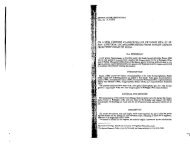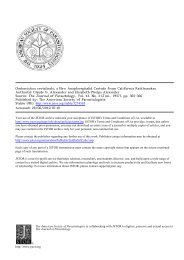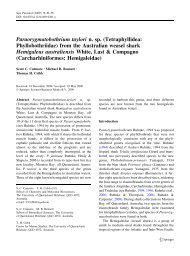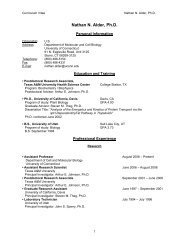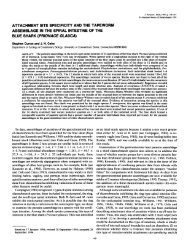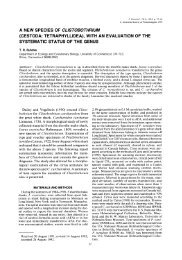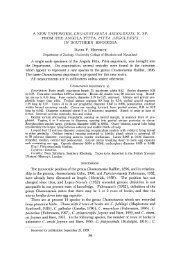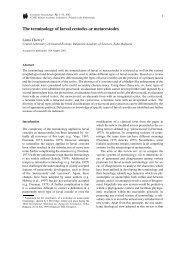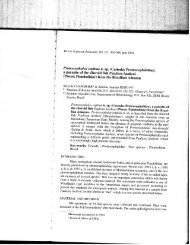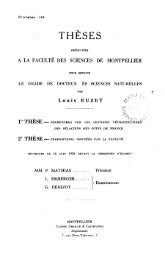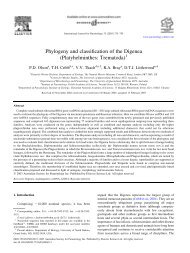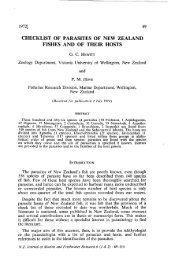Morphological Adaptations of Intestinal Helminths
Morphological Adaptations of Intestinal Helminths
Morphological Adaptations of Intestinal Helminths
Create successful ePaper yourself
Turn your PDF publications into a flip-book with our unique Google optimized e-Paper software.
866 THE JOURNAL OF PARASITOLOGY, VOL. 77, NO. 6, DECEMBER 1991endoderm or digestive tract and with no survivingfree-swimming or ectoparasitic ancestralforms, von Ihering reasoned that they are themost ancient <strong>of</strong> the parasitic worms." From suchreasoning it would be concluded that the tapeworms<strong>of</strong> fishes are more ancient and thereforebetter adapted to their hosts than those <strong>of</strong> othervertebrates. Indeed, some <strong>of</strong> the best examples<strong>of</strong> morphological adaptation to the intestinal microenvironmentmay be seen in the cestodes <strong>of</strong>elasmobranchs.MORPHOLOGY OF THE VERTEBRATEINTESTINEAccording to Crompton (1973), "The most obviousdifferences between the histology <strong>of</strong> the[intestinal] tracts <strong>of</strong> different vertebrates occurin the mucosa. The extensions and ramifications<strong>of</strong> the mucosa <strong>of</strong> the small intestine are indicative<strong>of</strong> the amount <strong>of</strong> absorptive and secretory activityand the amount <strong>of</strong> food available for the species<strong>of</strong> helminth which browse on the mucosa.The greatest development <strong>of</strong> the mucosa is seenin birds and mammals, where in addition to foldingthere may be as many as 40 villi per mm2 <strong>of</strong>intestinal surface and 3,000 microvilli per epithelialcell per villus. It appears, therefore, thatpotentially more environments will be presentfor small helminths in the small intestines <strong>of</strong>birds and mammals than in those <strong>of</strong> fish, amphibians,and reptiles."Significant differences in mucosal structureamong members <strong>of</strong> the same genus also havebeen reported, as illustrated by Williams (1960)who compared histological sections <strong>of</strong> the spiralvalve <strong>of</strong> 3 species Raja, showing what the surfacewould look like to an observer in the lumen. Heattributed host specificity to the observation thatthe scolex appeared to interlock with mucosalfolds and villi.SITE SELECTIONMucosal architecture varies not only amongspecies, but also from region to region in thesame animal. Crompton (1973) concluded thatthe greatest degree <strong>of</strong> morphological variation isseen in the alimentary tracts <strong>of</strong> teleost fishes.Analysis <strong>of</strong> helminth distribution in the alimentarytract <strong>of</strong> the flounder demonstrated quiteclearly the spatial stratification <strong>of</strong> niches in theintestine occupied by the different species, andit revealed patterns <strong>of</strong> seasonal and age differencesin parasite distribution (MacKenzie andGibson, 1970).Interactive site selection by intestinal helminthshas been well documented for experimentalinfections <strong>of</strong> Hymenolepis diminuta andMoniliformis moniliformis (=Moniliformis dubius)in the rat (Holmes, 1973). Examining naturalinfections <strong>of</strong> the white sucker, Catostomuscommersoni, Grey and Hayunga (1980) foundthat the cestode Glaridacris laruei was displacedfrom its typical site in the posterior gut by largenumbers <strong>of</strong> the acanthocephalan Pomphorhynchusbulbocolli. From this observation they concludedthatthe habitat range <strong>of</strong> G. laruei is greater than had beenthought previously, and the fundamental niche <strong>of</strong> thisspecies appears necessarily broader than that <strong>of</strong> P. bulbocolli.Our data suggest that G. laruei is a "generalist"and P. bulbocolli a "specialist," at least with regard tospace (terminology <strong>of</strong> Colwell and Fuentes, 1975). Thespecialist is able to exclude the generalist either by moreefficient utilization <strong>of</strong> a critical resource or by someform <strong>of</strong> interference, while the generalist is capable <strong>of</strong>establishing in adjacent habitats.In this regard, it is certainly appropriate to viewa suitable mucosal topography as one <strong>of</strong> the criticalresources required by an intestinal parasite.Clearly, morphological adaptation has a bearingupon site selection, just as it had upon hostspecificity. Presumably the specialist, the wormthat is highly adapted to the topography <strong>of</strong> itspreferred site, will attach itself more efficientlyand be a better competitor. However, as demonstratedby G. laruei, there are times when beinga generalist is a better strategy. <strong>Intestinal</strong> helminthshave found success using both strategies.Their various approaches are described in detailin Crompton's (1973) review.MORPHOLOGICAL ADAPTATIONS OFPARASITESAs Crompton (1973) observed, "The presence<strong>of</strong> nematodes in so many sites in the intestine isprobably related to their having an alimentarytract, and to the small size <strong>of</strong> many species whichis likely to facilitate the colonization <strong>of</strong> numerousnooks and crannies inaccessible to acanthocephalansand cestodes." Specialized attachment organsdid not evolve in nematodes and their feedingapparatus became adapted for burrowing andattachment whereas their digestive systems becamemodified to cope with the variety <strong>of</strong> materialsswallowed. Parasitic nematodes "feed ina variety <strong>of</strong> ways, many <strong>of</strong> these being independent<strong>of</strong> the host's digestive physiology" (Crompton,1973). The nematode cuticle plays an im-
HAYUNGA-MORPHOLOGICAL ADAPTATIONS OF INTESTINAL HELMINTHS 867portant role in protection, osmoregulation, andpossibly locomotion; its structure was describedin detail by Lee (1966).Digenetic trematodes have well developedventral suckers, facilitating attachment and enablingthem to browse on the mucosa. As suggestedby Crompton (1973), "the cellular debrisproduced during the constant renewal <strong>of</strong> the intestinalepithelium may be a major item in thediet <strong>of</strong> many trematodes, and the rapid epithelialturnover rate may explain, in part, how largepopulations <strong>of</strong> grazing trematodes can be supportedin the alimentary tract." The trematodetegument is arranged as a "sunken epidermis"consisting <strong>of</strong> a syncytial surface layer connectedby internuncial processes to subtegumental cytonslying below the layer <strong>of</strong> cuticular muscles;the syncytium contains prominent spines that"probably assist the parasite in retaining its positionin the host" (Lee, 1966). The tegumentalsurface <strong>of</strong> the bloodstream-dwelling Schistosomatidaeis modified by the presence <strong>of</strong> a heptalaminatesurface membrane that presumablyplays a role in protecting helminths bathed in asea <strong>of</strong> immunoglobulins (Hockley, 1973). Uptake<strong>of</strong> nutrients by trematodes can occur boththrough the gut and tegument; however, the relativenutritional roles <strong>of</strong> these surfaces in vivois not clear (Pappas, 1988).Strigeid trematodes utilize a complex adhesiveorgan to maintain attachment to the mucosa(Erasmus, 1977). Unlike the general tegumentcovering most <strong>of</strong> the worm's body, the tegument<strong>of</strong> the adhesive organ is highly modified withspecialized invaginations, or pits, and lappets withdistinctive setae and lappet gland cells. As Erasmus(1969) reported,When the adult Apatemon becomes attached to themucosa <strong>of</strong> the host, a host tissue plug, consisting largely<strong>of</strong> the intestinal villus divested <strong>of</strong> its mucosal epithelium,lies between the adhesive organ lobes. In thisway the inner face <strong>of</strong> each adhesive organ lobe comesinto very intimate contact with the host's lamina propria.Under the light microscope the association appearsto be so intimate that it is <strong>of</strong>ten impossible todistinguish precisely the extent <strong>of</strong> the parasite tegument.Proposed functions for the adhesive organs haveincluded adhesion to the host, the release <strong>of</strong> histolyticsecretions, and extracorporeal digestionand the absorption <strong>of</strong> nutrients; although supportedby little direct evidence, the concept <strong>of</strong>the adhesive organ having a "placental role" isan intriguing notion (Erasmus and Ohman, 1963;Erasmus, 1977).Acanthocephalans are firmly anchored by theircharacteristic armed proboscis that embeds itselfinto the submucosa. Lacking a gut, they absorbnutrients through their trunk. The acanthocephalanbody wall is a complex syncytium, with numerouspores and canals, and several structurallydistinct layers, serving both a protective and absorptivefunction (Lee, 1966). Van Cleave (1952)suggested that the proboscis might absorb nutrientsdirectly from host tissues. But accordingto Crompton (1973) this possibility is not easilysupported because "the surface area <strong>of</strong> the proboscisis very small compared with that <strong>of</strong> thetrunk, and the fact that the proboscis <strong>of</strong>ten elicitsan inflammatory response, followed by the deposition<strong>of</strong> fibrous material, means that access<strong>of</strong> nutrients to the proboscis is likely to be impeded."Of striking similarity to the strigeid adhesiveorgan are the tegumental modifications seen inthe acanthor stage <strong>of</strong> the the acanthocephalan M.moniliformis, as depicted by Crompton (1975).After penetrating the intestinal tissues <strong>of</strong> its invertebratehost, the cockroach Periplaneta americana,the acanthor becomes surrounded by hosthemocytes. Although by no means proven, thereis the visual suggestion that such surface amplificationmay serve to protect the parasite fromhost rejection by keeping the tegument properand the host cells apart.Because cestodes must obtain all <strong>of</strong> their nutrientsthrough the tegument, their surfaces havebeen among those most studied. As early as 1874,Schiefferdecker (1874) observed hairlike projectionson the tegumental surface <strong>of</strong> Taenia; suchprojections closely resembled the brush borderfound on intestinal epithelium. Using informationobtained from electron microscopic studies,Beguin (1966) drew the analogy between the cestodetegument and intestinal epithelium, and heenvisioned a distinction between the absorptivefunctions <strong>of</strong> the surface membrane and distalcytoplasm and the other functions <strong>of</strong> organellesfound more proximally. However, the fingerlikeextensions <strong>of</strong> the tapeworm's surface appear morecomplex than intestinal microvilli, as they consist<strong>of</strong> both a proximal, microvilluslike shaft, anda distal tapered spine. The term microthrix (plural,microtriches) was proposed by Rothman(1959) to describe this surface modificationunique to cestodes.The primary function <strong>of</strong> the microtriches was
868 THE JOURNAL OF PARASITOLOGY, VOL. 77, NO. 6, DECEMBER 1991thought to be surface amplification, as the efficientabsorption <strong>of</strong> nutrients by the tegument wasessential for helminths that had no gut. Microtricheswere also implicated in protection fromthe host (Morseth, 1966; McVicar, 1972), anchoring(Rothman, 1963; Mount, 1970; Hayungaand Mackiewicz, 1975), and locomotion(Rothman, 1963; Berger and Mettrick, 1971).Other suggestions have included the possibilitythat the microtriches might anchor the parasiteby interdigitating with the intestinal microvilli(Rothman, 1963) or that the spines might actlike cilia to facilitate absorption by agitating themicrohabitat and thus recirculating the intestinalcontents (Rietschel, 1935). There is strong evidencethat "membrane digestion" (adsorption <strong>of</strong>digestive enzymes by the surface membrane) occursin cestodes (Smyth, 1972) and that contactstimulus between the mucosa and the scolex maytrigger strobilization and development (Smyth,1969a); however, the role <strong>of</strong> the microtriches inthese processes is not clearly defined.Some very revealing clues about microthrixfunction were obtained from observations madeby Braten (1968) who carefully compared thesurfaces <strong>of</strong> larval and adult specimens <strong>of</strong> Diphyllobothriumlatum. As a result <strong>of</strong> detailedmeasurements from electron micrographs, heobserved that both the number and size <strong>of</strong> thetegumental microtriches <strong>of</strong> D. latum adults weresignificantly greater than those <strong>of</strong> the plerocercoidstage. This represented a significant surfacearea amplification that could be correlated withthe increased metabolic demands <strong>of</strong> transitionfrom the intermediate to the definite host. However,his measurements further revealed that most<strong>of</strong> the growth in the microtriches occurred in theproximal shaft whereas the size <strong>of</strong> the distal spineremained relatively constant. From this he concludedthat the shaft <strong>of</strong> the microthrix was involvedin nutrient absorption but that the spinemust have some other function, perhaps protectionor anchoring. An anchoring function for themicrothrix spine was given further support bythe work <strong>of</strong> Mount (1970) who showed that therostellar hooks <strong>of</strong> Taenia crassiceps appear todevelop directly from microtriches with unusuallylarge spines.The greatest amount <strong>of</strong> variation in attachmentorgans is seen in cestodes, particularly those<strong>of</strong> fishes. The rosette <strong>of</strong> the monozoic cestodariansappears to be a delicate holdfast organwhereas the larger, strobilated eucestodes requirethe stronger attachment afforded by a scolex. Thecestodes <strong>of</strong> elasmobranchs display an impressivevariety <strong>of</strong> holdfast modifications, with elaboratebothridia and a fingerlike projection <strong>of</strong> the scolex,the myzorhynchus, that penetrates the mucosato afford an even firmer anchoring. As illustratedby Williams et al. (1970), the scolex<strong>of</strong>ten appears tailored for an exact fit with themucosal villi <strong>of</strong> its host. "Williams dispelled thesuggestion that the scolex subsequently grows t<strong>of</strong>it in with the host's mucosa after the establishment<strong>of</strong> infection by stressing that the main features<strong>of</strong> scolex morphology are present at an earlydevelopmental stage. In a young specimen <strong>of</strong>Echeneibothrium sp. the scolex is almost identicalin size and form with that <strong>of</strong> an adult specimen"(Crompton, 1973).In his examination <strong>of</strong> the parasite-host interface<strong>of</strong> 3 tetraphyllidean species, McVicar (1972)observed that the tegument <strong>of</strong> the bothridial rim<strong>of</strong> Acanthobothrium quadripartitum was attachedso firmly that parts <strong>of</strong> the host mucosalcells appear to be pulled apart, leaving noticeableintracellular spaces. Examination <strong>of</strong> the sites <strong>of</strong>bothridial attachment for the other species revealeda breakdown <strong>of</strong> the host intestinal microvilliand the accumulation <strong>of</strong> membrane-boundosmophilic material in the host cells. In Echeneibothrium,species <strong>of</strong> which possess a myzorhynchus,the intestine showed signs <strong>of</strong> severedamage at the site <strong>of</strong> penetration. Both the presence<strong>of</strong> tegumental microtriches with well developedproximal shafts and the high level <strong>of</strong>alkaline phosphatase activity in the tegument <strong>of</strong>the myzorhynchus, together with the obviousdegradation <strong>of</strong> host tissue, lend credence toSmyth's (1969b) suggestion <strong>of</strong> a "placental role"for the attachment organs <strong>of</strong> at least some cestodespecies.HOST RESPONSE TO THE PARASITEFor the most part the host response to intestinalhelminths involves a typical inflammatoryreaction (see review by Befus and Bienenstock,1982). Histological changes in the mucosa followinginfection may include goblet cell hyperplasia(Ackert et al., 1939), hyperplasia <strong>of</strong> thepaneth cells (Roberts-Thomson et al., 1976),villus atrophy and crypt hyperplasia (Symons,1965; Manson-Smith et al., 1979), and the typicalhistopathological changes associated with anintestinal granulomatous response (Jones andRubin, 1974).McVicar (1972) had concluded that "variationin the degree <strong>of</strong> damage inflicted by the bothridia
HAYUNGA-MORPHOLOGICAL ADAPTATIONS OF INTESTINAL HELMINTHS 869FIGURE 1. Section through a nodule <strong>of</strong> Hunterellanodulosa, showing loss <strong>of</strong> epithelium at the opening <strong>of</strong>the nodule and hyperplasia <strong>of</strong> the submucosal tissue.Note how the posterior part <strong>of</strong> the worm extends intothe lumen <strong>of</strong> the gut (plastic section, toluidine blue).(From Hayunga and Mackiewicz [1975], courtesy <strong>of</strong>Pergamon Press.)<strong>of</strong> the tapeworms <strong>of</strong> R. naevus seems to dependpartly on the cestode's size, mode <strong>of</strong> attachmentand ability to move." The results <strong>of</strong> his examination<strong>of</strong> the parasite-host interface <strong>of</strong> tetraphyllideanssuggested a strong relationship betweenscolex structure and intestinal damage.Around the same time as that study, Mackiewicz(1972) was independently asking similar questionsabout caryophyllidean cestodes. Caryophyllideansdisplay considerable variation inscolex structure, ranging from the totally undifferentiatedanterior surface <strong>of</strong> Hunterella nodulosato species whose attachment organs includebothria, loculi, and terminal discs, each in variousdegrees <strong>of</strong> development. Furthermore, theirrestriction to cyprinid fishes should allow for directcomparisons <strong>of</strong> intestinal damage.Mackiewicz et al. (1972) reported that thegreatest degree <strong>of</strong> intestinal damage was observedfor those caryophyllidean species withpoorly developed attachment organs. Monobothriumingens, H. nodulosa, Monobothrium ulmeri,and Biacetabulum biloculoides were eachassociated with pronounced granulomatous reactions,resulting in the formation <strong>of</strong> conspicuousnodular lesions that in some cases containednecrotic material. The presence <strong>of</strong> an eosinophilic,perhaps mucoid, layer at the parasite-hostinterface, best seen in M. ulmeri, "varies fromspecies to species. It is generally absent wherethere is no tissue reaction and is most pronouncedin the nodules and other lesions." It isprobably a secretory product <strong>of</strong> the parasite; suchmaterial was suggested by Liu and Edward (1971)to function as an adhesive. In contrast, thosespecies with well developed, specialized holdfastorgans elicit little or no response; intestinal damageappears limited to compression <strong>of</strong> the villiand minor distortion <strong>of</strong> the shape <strong>of</strong> the crypts.This topic was pursued further by Hayunga(1977) who examined scolex structure <strong>of</strong> the mostundifferentiated species, H. nodulosa, at both thelight and electron microscopic levels. As shownin Figure 1, H. nodulosa is found in the anteriorgut, clustered within a nodular lesion characterizedby a loss <strong>of</strong> epithelium and extensive hyperplasia<strong>of</strong> the submucosal tissue. Althoughlacking holdfast organs, worms are anchoredfirmly in the nodule and must be removed forciblyfor examination. When relaxed, the posteriorportion <strong>of</strong> the parasite extends into the lumen<strong>of</strong> gut.Electron microscopic examination <strong>of</strong> the tegument<strong>of</strong> H. nodulosa revealed typical cestodemicrotriches covering the surface <strong>of</strong> the anteriorportion <strong>of</strong> the worm (Fig. 2). However, microtricheson the posterior surface were noteworthyin that they lacked the terminal spine (Fig. 3) andmore closely resembled the surface microvilli <strong>of</strong>the cestodarian Gyrocotyle urna as described byLyons (1969). These findings support earlier conclusionsthat the proximal shaft <strong>of</strong> the microthrixis primarily involved in the absorption <strong>of</strong> nutrients,whereas the spine assists in anchoring theparasite. However, as the crypt <strong>of</strong> the nodule isdevoid <strong>of</strong> host epithelium, any anchoring function<strong>of</strong> the microtriches must be achieved bymeans other than interdigitation with intestinalmicrovilli (Hayunga and Mackiewicz, 1975). Lack<strong>of</strong> phosphatase activity on the scolex surfacewould be consistent with the notion that the absorption<strong>of</strong> nutrients is restricted to the posteriorpart <strong>of</strong> the worm, and it suggests there may beregional differences in tegumental function (Hayunga,1979a). The idea <strong>of</strong> localized tegumentalactivity in flatworms was given further supportby experimental work on Schistosoma mansonireproductive behavior (Popiel and Basch, 1984).Light microscopic examination <strong>of</strong> the lesionassociated with H. nodulosa infection shows anarea <strong>of</strong> chronic inflammation and extensive infiltration<strong>of</strong> lymphocytes. A prominent eosinophilicmatrix is found between the parasite andhost tissue. Tegumental microtriches are so firmlyattached to this matrix that <strong>of</strong>ten portions <strong>of</strong>the tegument are left behind when worms areforcibly removed from the nodule (Hayunga,1977, 1979b). Electron microscopic examination
870 THE JOURNAL OF PARASITOLOGY, VOL. 77, NO. 6, DECEMBER 1991Iul#lIIIHHII rlul1u1!111lt!1lllf!( A,t.A^Q1mI>71111101111 11i1I110111110111110111-11111111011 111-100 -,'0 -~IO.5jmEFGH. ..IFIGURE 2. Diagram <strong>of</strong> the tegumental arrangementin the neck region <strong>of</strong> Hunterella nodulosa. cm, circularcuticular muscles; er, endoplasmic reticulum; g, golgi;gly, glycogen; lm, longitudinal cuticular muscles; m,microtriches; mit, mitochondrion; n, nucleus; no, nucleolus;r, rod-shaped bodies; v, vesicles (from Hayunga[1977]).reveals the eosinophilic matrix to be a secretoryproduct <strong>of</strong> the scolex, as large vesicles originatingfrom frontal glands were observed to be transportedtranstegumentally to release their contentsat the parasite-host interface; the failure <strong>of</strong>the frontal glands to stain for proteolytic enzymessuggests that the secretion is not lytic butrather adhesive in nature (Hayunga, 1979a,1979b). Because the frontal glands <strong>of</strong> H. nodulosaare better developed than those <strong>of</strong> othercaryophyllideans, they are very likely to play amajor role in attachment and penetration (Mackiewiczet al., 1972). However, the actual function<strong>of</strong> both the frontal glands and the Faserzellen or"neck cells" <strong>of</strong> caryophyllideans remains to bedemonstrated (Mackiewicz, 1972; Hayunga andMackiewicz, 1988).PARASITE EXPLOITATION OF HOSTRESPONSETypically, a parasite is viewed as challenginga host by its presence, then developing some kind<strong>of</strong> morphological or physiological adaptation toevade the host's response and thus avoid immunerejection. Citing the example <strong>of</strong> H. nodulosa,Hayunga (1989) inferred instead a more op-JFIGURE 3. Diagram showing variation in tegumentalmicrotriches <strong>of</strong> Hunterella nodulosa. A. Cross section<strong>of</strong> electron-dense spine. B. Cross section <strong>of</strong> microthrixshaft. C. Cross section <strong>of</strong> shaft <strong>of</strong> a spinelessmicrothrix. D. High magnification view <strong>of</strong> a rod-shapedbody found in the tegumental cytoplasm. E. Typicalcestode microthrix from the scolex. F. Branching microthrixwith short spine. G. Spineless microthrix fromposterior. H. Branching microthrix. I. Budding microthrix.J. Typical and spineless microtriches from atransitional zone <strong>of</strong> the tegument. K. Area <strong>of</strong> degeneratingmicrotriches on posterior part <strong>of</strong> worm. (FromHayunga and Mackiewicz [1975], courtesy <strong>of</strong> PergamonPress.)portunistic role for the parasite. Although theactual mechanisms <strong>of</strong> nodule formation are notknown, he suggested that the adhesive secretion<strong>of</strong> the frontal glands might also be an irritant andthat this secretion, together with the normallystrong muscular contractions <strong>of</strong> the worm, woulderode the epithelium and elicit a granulomatousresponse in the host. However, because <strong>of</strong> theworm's activity, the host is unable to completegranuloma formation. A partial granuloma isformed affording the parasite with a means <strong>of</strong>attachment, a sheltered habitat, and ready accessto nutrients found in the intestinal lumen (Hayunga,1977, 1979b).Such a possibility suggests that the parasite isK
HAYUNGA-MORPHOLOGICAL ADAPTATIONS OF INTESTINAL HELMINTHS 871capable <strong>of</strong> far more than passive evasion <strong>of</strong> hostdefenses and that, conceivably, parasites mayevolve strategies that actively exploit the host'sresponse for their own benefit (Hayunga, 1989).Careful examination <strong>of</strong> other parasites may revealthat strategies <strong>of</strong> exploitation are far morecommon than have previously been thought(Damian, 1987).COST OF SPECIALIZATIONSpecialization in terms <strong>of</strong> morphological adaptationhas resulted in highly efficient means <strong>of</strong>attachment for some intestinal helminths thatpresumably have given these species a competitiveedge. By adapting so well to their preferredsites, cestodes appear to be specialists with regardto space. To a somewhat lesser degree, trematodesand acanthocephalans also may be regardedas specialists. Nematodes seem less limitedin site selection by their anatomy and thus appearto be generalists in this regard, although theirhabitat selection may be restricted by physiologicalfactors. For nematodes it would appear thatniche stratification is more a question <strong>of</strong> whatthey eat rather than where they eat.Although the specialist may be highly efficient,the cost <strong>of</strong> specialization is dependence on onetype <strong>of</strong> host, as clearly demonstrated by studies<strong>of</strong> host specificity. One need only ask the question,"Whatever happened to the parasites <strong>of</strong> thedinosaurs?" to envision the risks <strong>of</strong> a strategy <strong>of</strong>specialization. But, if anything, helminths haveshown themselves to be highly resilient and innovative,as shown by the ability <strong>of</strong> polystomatidmonogeneans to inhabit both the gills <strong>of</strong> tadpolesand the urinary bladders <strong>of</strong> adult frogs, or by thestrategy <strong>of</strong> neotenic development when a desiredhost is no longer available. The morphologicaladaptations described here represent only oneexample <strong>of</strong> many highly effective strategies forsurvival.ACKNOWLEDGMENTSI am grateful to Robin M. Overstreet and JohnC. Holmes, both for inviting me to speak at thissymposium and for keeping me on the programdespite the turmoil <strong>of</strong> world events this year. Iparticularly acknowledge the influence <strong>of</strong> JohnMackiewicz, who introduced me to the field <strong>of</strong>parasitology and to the fascinating Caryophyllidea.Many <strong>of</strong> the ideas that I discussed werelearned in his classes, and the original researchthat I described was done in his laboratory. Thespecimen shown in Figure 1 was prepared by Dr.Mackiewicz. Observations on competition andsite selection by caryophyllideans were made incollaboration with Anthony J. Grey, a fellowgraduate student, now at the New York StateDepartment <strong>of</strong> Health in Albany. Finally, I givecredit to the pioneering efforts <strong>of</strong> prominent parasitologistswhom I have quoted extensively inthis paper.LITERATURE CITEDACKERT, J. E., S. A. EDGAR, AND L. P. FRICK. 1939.Goblet cells and age resistance <strong>of</strong> animals to parasitism.Transactions <strong>of</strong> the American MicroscopicalSociety 58: 81-89.BEFUS, D., AND J. BIENENSTOCK. 1982. Factors involvedin symbiosis and host resistance at the mucosa-parasiteinterface. Progress in Allergy 31: 76-177.BEGUIN, F. 1966. Etude au microscope electroniquede la cuticule et de ses structures associ6es chezquelques cestodes. Essai d'histologie comparee.Zeitschrift fuir Zellforschung 72: 30-46.BERGER, J., AND D. F. METTRICK. 1971. Microtrichialpolymorphism among hymenolepid tapeworms asseen by scanning electron microscopy. Transactions<strong>of</strong> the American Microscopical Society 90:393-403.BRATEN, T. 1968. The fine structure <strong>of</strong> the tegument<strong>of</strong> Diphyllobothrium latum (L.)-A comparison <strong>of</strong>the plerocercoid and adult stages. Zeitschrift furParasitenkunde 30: 104-112.COLWELL, R. K., AND E. R. FUENTES. 1975. Experimentalstudies <strong>of</strong> the niche. Annual Review <strong>of</strong>Ecology and Systematics 6: 281-310.CROMPTON, D. W. T. 1973. The sites occupied bysome parasitic helminths in the alimentary tract<strong>of</strong> vertebrates. Biological Reviews 48: 27-83.1975. Relationships between Acanthocephalaand their hosts. Symposia <strong>of</strong> the Society forExperimental Biology 29: 467-504.DAMIAN, R. T. 1987. The exploitation <strong>of</strong> host immuneresponses by parasites. Journal <strong>of</strong> Parasitology73: 3-13.DOGIEL, V. A. 1958. Ecology <strong>of</strong> the parasites <strong>of</strong> freshwaterfishes. In Parasitology <strong>of</strong> fishes, V. A. Dogiel,G. K. Petrushka, and Y. I. Polyanski (eds.). LeningradUniversity Press. [English translation by Z.Kabata, Oliver & Boyd, Edinburgh, xi + 384 p.,1961.]ERASMUS, D. A. 1969. Studies on the host-parasiteinterface <strong>of</strong> strigeoid trematodes. V. Regional differentiation<strong>of</strong> the adhesive organ <strong>of</strong> Apatemongracilis minor Yamaguti, 1933. Parasitology 59:245-256.1977. The host-parasite interface <strong>of</strong> trematodes.Advances in Parasitology 15: 202-242., AND C. OHMAN. 1963. The structure andfunction <strong>of</strong> the adhesive organ in strigeid trematodes.Annals <strong>of</strong> the New York Academy <strong>of</strong> Sciences113: 7-35.GREY, A. J., AND E. G. HAYUNGA. 1980. Evidencefor alternative site selection by Glaridacris laruei(Cestoidea: Caryophyllidea) as a result <strong>of</strong> inter-
872 THE JOURNAL OF PARASITOLOGY, VOL. 77, NO. 6, DECEMBER 1991specific competition. Journal <strong>of</strong> Parasitology 66:371-372.HAYUNGA, E. G. 1977. Comparative histology <strong>of</strong> thescoleces <strong>of</strong> three caryophyllid tapeworms: Relationshipto pathology and site selection in the hostintestine. Dissertation Abstracts International. B:The Sciences and Engineering 38: 1999.* 1979a. The structure and function <strong>of</strong> the scolexglands <strong>of</strong> three caryophyllid tapeworms. Proceedings<strong>of</strong> the Helminthological Society <strong>of</strong> Washington46: 171-179.. 1979b. Observations on the intestinal pathologycaused by three caryophyllid tapeworms<strong>of</strong> the white sucker Catostomus commersoni Lacepede.Journal <strong>of</strong> Fish Diseases 2: 239-248.1989. Parasites and immunity: Tactical considerationsin the war against disease-Or, howdid the worms learn about Clausewitz? Perspectivesin Biology and Medicine 32: 349-370., AND J. S. MACKIEWICZ. 1975. An electronmicroscope study <strong>of</strong> the tegument <strong>of</strong> Hunterellanodulosa Mackiewicz and McCrae, 1962 (Cestoidea:Caryophyllidea). International Journal forParasitology 5: 309-319., AND . 1988. Comparative histology <strong>of</strong>the scolex and neck region <strong>of</strong> Glaridacris laruei(Lamont, 1921) Hunter, 1927 and Glaridacris catostomiCooper, 1920 (Cestoidea: Caryophyllidea).Canadian Journal <strong>of</strong> Zoology 66: 790-803.HOCKLEY, D. 1973. Ultrastructure <strong>of</strong> the tegument<strong>of</strong> Schistosoma. Advances in Parasitology 11:233-305.HOLMES, J. C. 1973. Site selection by parasitic helminths:Interspecific interactions, site segregation,and their importance to the development <strong>of</strong> helminthcommunities. Canadian Journal <strong>of</strong> Zoology51: 333-347.JONES, C. E., AND R. RUBIN. 1974. Nematospiroidesdubius: Mechanisms <strong>of</strong> host immunity. I. Parasitecounts, histopathology, and serum transfer involvingorally or subcutaneously sensitized mice.Experimental Parasitology 35: 434-452.KNORRE, A. G. 1937. The distribution <strong>of</strong> parasitesin hosts and the problem <strong>of</strong> specificity. LeningradUniversitet Uchenye Zapiski 13, Seriia BiologicheskaiaNauk 3(4): 21-28. [In Russian.]LEE, D. L. 1966. The structure and composition <strong>of</strong>the helminth cuticle. Advances in Parasitology 4:187-254.Liu, S.-K., AND G. EDWARD. 1971. Gastric ulcersassociated with Contracaecum spp. (Nematoda:Ascaroidea) in a Stellar sea lion and a white pelican.Journal <strong>of</strong> Wildlife Diseases 7: 266-271.LYONS, K. M. 1969. The fine structure <strong>of</strong> the bodywall <strong>of</strong> Gyrocotyle urna. Zeitschrift fur Parasitenkunde33: 95-109.MACKENZIE, K., AND D. GIBSON. 1970. Ecologicalstudies <strong>of</strong> some parasites <strong>of</strong> plaice, Pleuronectesplatessa (L.) and flounder, Platichthys flesus (L.).In Aspects <strong>of</strong> fish parasitology, A. E. R. Taylorand R. Muller (eds.). Symposia <strong>of</strong> the British Societyfor Parasitology 8: 1-42.MACKIEWICZ, J. S. 1972. Caryophyllidea (Cestoidea):a review. Experimental Parasitology 31: 417-512., G. E. COSGROVE, AND W. D. GUDE. 1972.Relationship <strong>of</strong> pathology to scolex morphologyamong caryophyllid cestodes. Zeitschrift fur Parasitenkunde39: 233-246.MANSON-SMITH, D. F., R. G. BRUCE, AND D. M. V.PARROTT. 1979. Villous atrophy and expulsion<strong>of</strong> intestinal Trichinella spiralis are mediated byT Cells. Cellular Immunology 47: 285-292.MCVICAR, A. H. 1972. The ultrastructure <strong>of</strong> the parasite-hostinterface <strong>of</strong> three tetraphyllidean tapeworms<strong>of</strong> the elasmobranch Raja naevus. Parasitology65: 77-88.MORSETH, D. J. 1966. The fine structure <strong>of</strong> the tegument<strong>of</strong> adult Echinococcus granulosus, Taeniahydatigena and Taenia pisiformis. Journal <strong>of</strong> Parasitology52: 1074-1085.MOUNT, P. M. 1970. Histogenesis <strong>of</strong> the rostellarhooks <strong>of</strong> Taenia crassiceps (Zeder, 1800) (Cestoidea).Journal <strong>of</strong> Parasitology 5: 947-961.PAPPAS, P. W. 1988. The relative roles <strong>of</strong> the intestinesand external surfaces in the nutrition <strong>of</strong>monogeneans, digeneans and nematodes. Parasitology96: S 105-S 121.POPIEL, I., AND P. F. BASCH. 1984. Reproductive development<strong>of</strong> female Schistosoma mansoni (Digenea:Schistosomatidae) following bisexual pairing<strong>of</strong> worms and worm segments. Journal <strong>of</strong>Experimental Zoology 232: 141-150.RIETSCHEL, P. E. 1935. Zur Bewegungsphysiologieder Cestoden. Zoologischer Anzeiger 111: 109-111.ROBERTS-THOMSON, I. C., D. I. GROVE, D. P. STEVENS,AND K. S. WARREN. 1976. Suppression <strong>of</strong> giardiasisduring the intestinal phase <strong>of</strong> trichinosis inthe mouse. Gut 17: 953-958.ROTHMAN, A. H. 1959. The physiology <strong>of</strong> tapeworms,correlated to structures seen with the electronmicroscope. Journal <strong>of</strong> Parasitology 45(4, Sec.2): 28.. 1963. Electron microscope studies <strong>of</strong> tapeworms:The surface structures <strong>of</strong> Hymenolepisdiminuta (Rudolphi, 1819) Blanchard, 1892.Transactions <strong>of</strong> the American Microscopical Society82: 22-30.SCHIEFFERDECKER, P. 1874. Beitrage zur Kenntnessdes feineren Baues der Taenien. Zeitschrift fur Naturwissenschaften8: 459-487.SHULMAN, S. S. 1954. Concerning the specificity <strong>of</strong>fish parasites. Zoologicheskii Zhurnal 33: 14-25.[W. E. Ricker, Fisheries Research Board <strong>of</strong> Canada,Translation Series No. 177, Nanaimo, B.C.,Canada, 1958.]SMYTH, J. D. 1969a. Parasites as biological models.Parasitology 59: 73-91.. 1969b. The physiology <strong>of</strong> cestodes. W. H.Freeman & Co., San Francisco, xiii + 279 p.. 1972. Changes in the digestive-absorptivesurface <strong>of</strong> cestodes during larval/adult differentiation.In Functional aspects <strong>of</strong> parasite surfaces,Vol. 10, A. E. R. Taylor and R. Muller (eds.).Symposia <strong>of</strong> the British Society for Parasitology,p. 41-70.STUNKARD, H.W. 1957. Host-specificity and parallelevolution <strong>of</strong> parasitic flatworms. Zeitschrift furTropenmedizin und Parasitologie 8: 254-263.SYMONS, L. E. A. 1965. Kinetics <strong>of</strong>the epithelial cells,and morphology <strong>of</strong> villi and crypts in the jejunum<strong>of</strong> the rat infected by the nematode Nippo-
HAYUNGA-MORPHOLOGICAL ADAPTATIONS OF INTESTINAL HELMINTHS 873strongylus brasiliensis. Gastroenterology 49: 158-168.VAN CLEAVE, H. 1952. Some host-parasite relationships<strong>of</strong> the Acanthocephala, with special referenceto the organs <strong>of</strong> attachment. ExperimentalParasitology 1: 305-330.WILLIAMS, H. H. 1960. The intestine in members <strong>of</strong>the genus Raja and host-specificity in the Tetraphyllidea.Nature 188: 514-516., A. H. MCVICAR, AND R. RALPH. 1970. Thealimentary canal <strong>of</strong> fish as an environment forhelminth parasites. In aspects <strong>of</strong> fish parasitology,Vol. 8, A. E. R. Taylor and R. Muller (eds.). Symposia<strong>of</strong> the British Society for Parasitology, p. 43-77.



